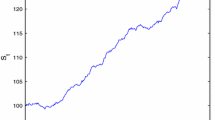Abstract
This paper investigates a dynamic asset allocation problem for loss-averse investors in a jump-diffusion model where there are a riskless asset and N risky assets. Specifically, the prices of risky assets are governed by jump-diffusion processes driven by an m-dimensional Brownian motion and a (N − m)-dimensional Poisson process. After converting the dynamic optimal portfolio problem to a static optimization problem in the terminal wealth, the optimal terminal wealth is first solved. Then the optimal wealth process and investment strategy are derived by using the martingale representation approach. The closed-form solutions for them are finally given in a special example.
Similar content being viewed by others
References
Bardhan, I., Chao, X. Martingale analysis for assets with discontinuous returns. Mathematics of Operations Research, 20(1): 243–256 (1995)
Bellamy, N. Wealth optimization in an incomplete market driven by a jump-diffusion process. Journal of Mathematical Economics, 35: 259–287 (2001)
Berkelaar, A.B., Kouwenberg, R., Post, T. Optimal portfolio choice under loss aversion. Review of Economics and Statistics, 86(4): 973–987 (2004)
Callegaro, G., Vargiolu, T. Optimal portfolio for HARA utility functions in a pure jump multidimensional incomplete market. International Journal of Risk Assessment and Management, 11: 180–200 (2009)
Cei, C. An HJB approach to exponential utility maximization for jump processes. International Journal of Risk Assessment and Management, 11: 104–121 (2009)
Gomes, F.J. Portfolio choice and trading volume with loss-averse investors. Journal of Business, 78(2): 675–706 (2005)
Guo, W.J., Xu, C.M. Optimal portfolio selection when stock prices follow an jump-diffusion process. Mathematical Methods of Operations Research, 60: 485–496 (2004)
Jeanblanc-Picque, M., Pontier, M. optimal portfolio or a small investor in a mark model with discontinuous prices. Applied Mathematics and Optimization, 22: 2877–310 (1990)
Kahneman, D., Tversky, A. Prospect theory-analysis of decision under risk. Econometrica, 47(2): 263–291 (1979)
Lim, A.E.B. Mean-variance hedging when there are jumps. SIAM Journal on Control and Optimization, 44(5): 1893–1922 (2005)
Mi, H., Zhang, S.G. Dynamic portfolio selection for loss-averse investors with wealth constraints. Systems Engineering-Theory and Practice, 33(5): 1107–1115 (2013)
Nakano, Y. Minimization of shortfall risk in a jump-diffusion model. Statistics and Probability Letters, 67: 87–95 (2004)
Øsendal, B., Sulem, A. Maximum principles for optimal control of forward-backward stochastic differential equations with jumps. SIAM Journal on Control and Optimization, 48(5): 2945–2976 (2009)
Shi, J.T., Wu, Z. Maximum principle for forward-backward stochastic control system with random jumps and applications to finance. Journal of Systems Science and Complexity, 23(2): 219–231 (2010)
Shi, J.T., Wu, Z. A stochastic maximum principle for optimal control of jump diffusions and applications to finance. Chinese Journal of Applied Probability and Statistics, 27(2): 127–137 (2011)
Tversky, A., Kahneman, D. Advances in prospect-theory- cumulative representation of uncertainty. Journal of Risk and Uncertainty, 5(4): 297–323 (1992)
Zeng, Y., Li, Z. Asset-liability management under benchmark and mean-variance criteria in a jump diffusion market. Journal of Systems Science and Complexity, 24(2): 317–327 (2011)
Karatzas, I., Shreve, S.E. Methods of Mathematical Finance. Springer-Verlag, New York, 1998
Shreve, S.E. Stochastic Calculus Models for Finance: Continuous Time Models. Springer-Verlag, New York, 2005
Author information
Authors and Affiliations
Corresponding author
Additional information
Supported by the National Natural Science Foundation of China (No.61304065, 11471304, 11401556), and the Natural Science Foundation of the Jiangsu Higher Education Institutions of China (No.12KJB110011).
Rights and permissions
About this article
Cite this article
Mi, H., Bi, Xc. & Zhang, Sg. Dynamic asset allocation with loss aversion in a jump-diffusion model. Acta Math. Appl. Sin. Engl. Ser. 31, 557–566 (2015). https://doi.org/10.1007/s10255-015-0485-1
Received:
Revised:
Published:
Issue Date:
DOI: https://doi.org/10.1007/s10255-015-0485-1




